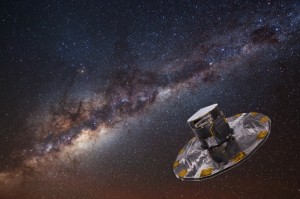A proposal with title A Gaia and Herschel Study of the Density Distribution and Evolution of Young Massive Star Clusters was submitted to the EC Horizon 2020 – Space call on April 2015. The proposal has just been accepted. The consortium is led by the University of Leeds, and has participation from the Cardiff University and Universite Joseph Fourier Grenoble 1.
The key scientific aim of this proposal is to combine data from two of the European Space Agency major space missions, Gaia and Herschel Space Observatory, together with ground based facilities, to constrain the mechanisms that underlie massive star and star cluster formation.
Object Names: 30 Doradus, 30 Dor
Image Type: Astronomical/Annotated
Credit: NASA, ESA, and F. Paresce (INAF-IASF, Bologna, Italy), R. O’Connell (University of Virginia, Charlottesville), and the Wide Field Camera 3 Science Oversight Committee
QUASAR Science Resources involvement in the project deals with the creation of the necessary software tools in order to handle the algorithms for mass inversion for youngest clusters and the visualization of the results of the analysis. The software package will consist of a Virtual Infrastructure that will contain the algorithm plus accompanying software, Client/Sever systems to interact with it, Client/Sever access to the Gaia and other external, if needed, Archives, and Client/Sever systems for the 3D visualization of the analysis results.
Gaia is an ESA mission to chart a three-dimensional map of our Galaxy. Its main objective, is to give information on the composition, formation and evolution of the Galaxy. Gaia will provide unprecedented positional and radial velocity measurements with the accuracies needed to produce a stereoscopic and kinematic census of about one billion stars in our Galaxy and throughout the Local Group. This amounts to about 1 percent of the Galactic stellar population.
Date: 27 June 2013
Satellite: Gaia
Image Credit: ESA/ATG medialab; background image: ESO/S. Brunier
ESA’s Herschel Space Observatory has the largest single mirror ever built for a space telescope. At 3.5-metres in diameter the mirror will collect long-wavelength radiation from some of the coldest and most distant objects in the Universe. In addition, Herschel is the only space observatory to cover a spectral range from the far infrared to sub-millimetre.
Date: 03 May 2010
Satellite: Herschel
Image Credit: ESA






